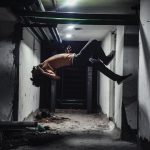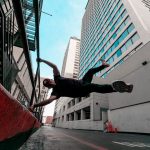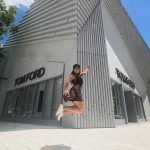Download links
How to install Mastering Parkour: The Art of Movement with taya773 APK?
1. Tap the downloaded Mastering Parkour: The Art of Movement with taya773 APK file.
2. Touch install.
3. Follow the steps on the screen.
Description
Parkour is a physical discipline that emphasizes efficient movement through an environment, often urban, by running, jumping, climbing, and vaulting over obstacles. It is not merely a sport but a philosophy that encourages practitioners, known as traceurs (male) or traceuses (female), to navigate their surroundings with creativity and fluidity. The essence of parkour lies in its focus on overcoming physical barriers and challenges, transforming the urban landscape into a playground for movement.
The practice has gained immense popularity over the years, transcending its roots to become a global phenomenon. The origins of parkour can be traced back to the late 20th century in France, where it was developed by David Belle and a group of friends who were inspired by the military obstacle course training known as “parcours du combattant.” Belle’s father, a firefighter, introduced him to various physical training methods that emphasized agility and strength.
The discipline gained further recognition through the influence of the Yamakasi, a group of French traceurs who showcased their skills in films and public performances. Their innovative movements and daring stunts captured the imagination of many, leading to the spread of parkour across Europe and eventually worldwide.
Key Takeaways
- Parkour is a physical discipline that involves moving through obstacles with speed and efficiency, originating from military obstacle course training in France.
- The fundamentals of parkour training include mastering basic movements like running, jumping, climbing, and balancing, as well as learning to adapt to different environments.
- Developing strength and agility is crucial for parkour, requiring a combination of bodyweight exercises, plyometrics, and flexibility training.
- Overcoming mental barriers in parkour involves building confidence, focus, and problem-solving skills to navigate challenging obstacles.
- Taya773’s approach to teaching and mastering parkour emphasizes safety, creativity, and adaptability, focusing on individual progression and self-expression.
The Fundamentals of Parkour Training
Fundamental Skills
These basic movements are essential for efficient and safe obstacle navigation.
Progressive Development
Training in parkour often begins with basic drills that focus on body mechanics and movement efficiency. Practitioners learn to perform rolls to dissipate impact when landing from heights, which is crucial for preventing injuries. As they progress, they incorporate more dynamic movements such as vaults and flips, which require a combination of strength, agility, and timing.
Building Confidence and Minimizing Risk
The emphasis on progressive training ensures that individuals build confidence in their abilities while minimizing the risk of injury. By developing a strong sense of balance, and incorporating more complex movements, practitioners can traverse challenging terrain with ease and confidence.
Developing Strength and Agility for Parkour

Strength and agility are paramount in parkour, as they directly influence a traceur’s ability to execute movements with precision and control. Strength training for parkour often focuses on functional exercises that mimic the demands of the discipline. Bodyweight exercises such as pull-ups, push-ups, squats, and core workouts are integral to building the necessary muscle groups used in parkour movements.
For example, pull-ups enhance upper body strength, which is crucial for climbing and vaulting over obstacles. Agility training complements strength development by improving a traceur’s ability to change direction quickly and maintain balance during dynamic movements. Plyometric exercises, such as box jumps and lateral hops, are commonly incorporated into training regimens to enhance explosive power and coordination.
Additionally, agility ladders and cone drills can be utilized to improve footwork and reaction time. By combining strength and agility training, practitioners can develop a well-rounded skill set that allows them to tackle increasingly complex challenges in their parkour journey.
Overcoming Mental Barriers in Parkour
| Barriers | Challenges | Strategies |
|---|---|---|
| Fear of Heights | Difficulty in jumping from high platforms | Gradual exposure, visualization, and controlled breathing |
| Lack of Confidence | Feeling unsure about executing difficult moves | Progressive training, positive self-talk, and support from peers |
| Mental Blocks | Struggling to overcome mental barriers | Mindfulness techniques, mental rehearsal, and seeking professional guidance |
While physical prowess is essential in parkour, mental fortitude plays an equally significant role in a traceur’s success. Many practitioners encounter mental barriers that can hinder their progress, such as fear of heights or anxiety about attempting new moves. Overcoming these psychological obstacles requires a combination of self-awareness, gradual exposure, and positive reinforcement.
For instance, a traceur who struggles with fear of falling may benefit from starting with lower obstacles and gradually increasing the height as their confidence grows. Visualization techniques can also be effective in overcoming mental barriers. By mentally rehearsing movements before attempting them physically, practitioners can create a sense of familiarity that reduces anxiety.
Additionally, fostering a supportive community can provide encouragement and motivation during challenging moments. Sharing experiences with fellow traceurs can help individuals realize that they are not alone in facing fears and doubts. Ultimately, developing mental resilience is crucial for pushing boundaries and achieving personal growth within the discipline.
Taya773’s Approach to Teaching and Mastering Parkour
Taya773 is a prominent figure in the parkour community known for her innovative teaching methods and dedication to helping others master the discipline. Her approach emphasizes inclusivity and accessibility, making parkour approachable for individuals of all skill levels. Taya773 believes that everyone can benefit from parkour training, regardless of their background or physical abilities.
She often incorporates elements of play into her sessions, encouraging participants to explore their movement potential without the pressure of competition. One of Taya773’s key teaching philosophies is the importance of building a strong foundation before progressing to advanced techniques. She emphasizes the significance of mastering basic movements such as rolls and landings before attempting more complex skills like flips or wall runs.
This method not only enhances safety but also instills confidence in her students as they witness their own progress over time. Taya773 also advocates for mindfulness during training sessions, encouraging practitioners to listen to their bodies and respect their limits while pushing themselves to grow.
Taking Parkour to the Next Level: Advanced Techniques and Training

Pushing Boundaries: Advanced Parkour Techniques
As practitioners become more proficient in parkour, they often seek to elevate their skills by exploring advanced techniques that challenge their physical capabilities and creativity. Advanced parkour techniques include wall flips, precision landings from greater heights, and complex vaults that require intricate body control. These movements demand not only strength but also an acute understanding of body mechanics and spatial awareness.
Mastering Advanced Techniques through Specialized Training
To master advanced techniques, practitioners must engage in specialized training that focuses on refining their skills through repetition and experimentation. This may involve setting up obstacle courses that simulate real-world environments or participating in workshops led by experienced traceurs who can provide valuable insights into technique refinement. Additionally, video analysis can be an effective tool for self-assessment; by recording their movements, practitioners can identify areas for improvement and track their progress over time.
Embracing Creativity and Self-Expression in Advanced Parkour
Moreover, advanced training often incorporates elements of creativity and self-expression. Practitioners are encouraged to develop their unique style by combining different movements into fluid sequences or “flows.” This artistic aspect of parkour allows individuals to showcase their personality while navigating obstacles in innovative ways. As they push their limits further, advanced traceurs often find themselves not only improving their physical abilities but also deepening their connection to the discipline itself.
A Transformative Journey: The Power of Parkour
In conclusion, parkour is a multifaceted discipline that encompasses physical prowess, mental resilience, and creative expression. From its origins in France to its global reach today, parkour continues to inspire individuals to challenge themselves both physically and mentally. Through dedicated training focused on fundamentals, strength development, overcoming mental barriers, and embracing advanced techniques, practitioners can embark on a transformative journey that transcends mere movement—ultimately fostering personal growth and self-discovery along the way.
FAQs
What is parkour?
Parkour is a physical discipline that involves moving through an environment in a creative and efficient way, using only the human body and the surroundings to propel oneself.
Where did parkour originate?
Parkour originated in France, developed by David Belle and his group of friends in the late 1980s. It was inspired by military obstacle course training and the natural movements of indigenous tribes in Africa.
What are the basic movements in parkour?
Basic movements in parkour include running, jumping, climbing, vaulting, and balancing. These movements are used to navigate obstacles and terrain in an efficient and fluid manner.
Is parkour dangerous?
Parkour can be dangerous if not practiced with proper training and safety precautions. It involves high-risk movements and requires a strong understanding of one’s physical capabilities and limitations.
Is parkour a competitive sport?
While parkour is not traditionally a competitive sport, there are organized events and competitions where practitioners can showcase their skills and creativity. However, the essence of parkour is more about personal expression and overcoming physical challenges.
What are the benefits of practicing parkour?
Practicing parkour can improve strength, agility, coordination, and mental focus. It also promotes creativity, problem-solving, and adaptability in various environments. Additionally, it can be a fun and engaging form of physical activity.





